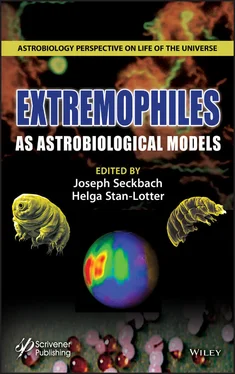1.2 Steam Cave and Vent Sites
Samples of steam were collected from fumaroles in four permanently protected geothermal areas, Lassen Volcanic National Park, Hawai’i Volcanoes National Park, Valles Caldera National Preserve, and Solfatara Crater, Italy ( Table 1.1). Our Hawai’i Volcanoes National Park sites are coded, as part of our collection agreement with the park. These sites have a wide and interesting variety of chemical steam caves and vents not seen in other geothermal areas. Our choice of Hawai’i as a site with an active volcano proved to be interesting. In many ways, its basaltic lava flows resemble those of our nearby planet Mars, both chemically and physically providing a match for using Earth’s extremophile life as a model for life on other planets. Mars is one of those planets close enough for experimental approaches and applications.
In active steam caves, meteoric waters characteristically descend through porous and fractured surface lava and eventually meet upward convection of heat and rising volcanic gases. Heat generates abundant steam that rises as a vapor-gas mixture through fractured lava crevices and fissures towards the surface. Near the surface, passageways—both horizontal and vertical—allow the vapors to condense on the cooler cave ceilings and walls, depositing characteristic chemical signatures and forming a matrix-like material rich in nutrients for extreme microorganisms. The steam exits the cave or vent opening and provides a diffused smoke-like flow known as a fumarole. Venting steam commonly proceeds in an artesian or burst flow. With large volumes of steam, visibility of the cave interior or vent opening can be obscured. Steam cave/vent openings can be small on the order of a few centimeters or large, one to three meters or larger for wide steam vents or vertical caves. Our selection of steam caves was based on the idea that while we and others [1.7] [1.10] [1.12] [1.16] had already investigated and identified organisms, especially Archaea in steam vents, there was not much information on organisms from those steam caves/vents regarding their in-situ appearance and some of the sites where they have previously been isolated left gaps in our information on the physical appearance of steam vent microorganisms at the structural level.
1.3 Steam Cave and Vent Sample Collection
The steam cave and vent sites were selected for their chemical properties. These were initially recognized in flowing hot springs as iron and sulfur. Here, deposition of iron occurred in the anoxic zone of the spring and at the point of disappearance of iron at the anoxic/oxic interface, sulfur deposition took place and finally iron deposits formed on the existing sulfur in the anoxic/oxic zone. The same phenomenon can be seen in very small sulfur caves where the interior has no sulfur, the cave opening is small and sulfur deposition occurs only at the anoxic/oxic interface or on the outer oxic surface, sometimes along with iron deposits over sulfur. The other categories, nonsulfur and salt (the latter so far only seen in Hawai’i), represent a departure from the flowing hot spring analogy. Nonsulfur steam caves have not yet been fully categorized, although unusual thin filamentous organisms have been enriched from the H5 salt cave, and from sulfur caves such as SW 3 in Lassen. Nonsulfur caves farther below are considered for their solid surface chemistry by means of energy dispersive X-ray microanalysis (EDX). Sampling of steam cave or vent ceilings depends on the nature of the surface. With highly acidic solfatara areas, cave ceilings can be delicate and sometimes only careful hand sampling is essential. With deeper nonsulfur caves sometimes encountered in Hawai’i, this is less of a problem because the cave ceilings are formed of hard lava and only shallow samples are obtained. However, sampling through a small opening into a deep cave interior is not without its challenges, principally resulting from the high level of heat encountered, with or without leather gloves.
Table 1.1 Fumarole sampling locations and physical properties.
| Location |
pH |
Temp (°C) |
Type |
Chemistry |
| Hawai’i Volcanoes National Park 1 |
|
|
|
|
| Hawai’i (1) |
5.5 |
65.0 |
Cave |
Nonsulfur |
| Hawai’i (2) |
5.2 |
68.0 |
Cave |
Nonsulfur |
| Hawai’i (3) |
3.0 |
82.0 |
Cave |
Sulfur |
| Hawai’i (4) |
3.0 |
82.0 |
Cave |
Iron/sulfur |
| Hawai’i (5) |
5.0 |
68.0 |
Cave |
Salt |
| Hawai’i (6) |
4.5 |
66.0 |
Cave |
Salt/sulfur |
| Lassen Volcanic National Park 2 |
|
|
|
|
| Sulphur Works, lower (1) |
4.5 |
87.0 |
Cave |
Nonsulfur |
| Sulphur Works, lower (2) |
3.2 |
93.0 |
Vent |
Sulfur |
| Sulphur Works, lower (3) |
4.0 |
91.5 |
Cave |
Sulfur |
| Sulphur Works, upper (4) |
3.0 |
85.5 |
Vent |
Iron |
| Sulphur Works, upper (5) |
2.5 |
81.2 |
Cave |
Iron |
| Valles Caldera National Preserve 3 |
|
|
|
|
| Sulphur Springs, New Mexico |
2.0 |
89.0 |
Cave |
Nonsulfur |
| Pozzuoli, Italy 4 |
|
|
|
|
| Solfatara Crater |
3.0 |
94.0 |
Vent |
Sulfur |
1 June 2016 sampling
2 Oct 2018 sampling
3 , 4 included for comparison
Samples of steam were collected from fumaroles in four permanently protected geothermal areas, Lassen Volcanic National Park, Hawai’i Volcanoes National Park, Valles Caldera National Preserve, and Solfatara Crater, Italy. Our steam collector ( Figure 1.1) consists of a stainless shroud with a central holder for the sample tube. The condenser with a splash shield fits into the shroud and is slightly raised at 3 points, allowing excess steam to bypass the edges of the condenser during collection. The central lower guide rod directs condensed steam water into a sterile 50 mL polypropylene tube. During steam collection the open tube rests in a holder attached near the bottom of the shroud. The steam condenser can be handheld, but is also used attached to a tripod by an external mount, which by design serves to protect samples from aerial contaminants. During collection, rising steam contacts the water-cooled condenser and the guide rod drains the condensed steam water directly into the collection tube. After collection, the tube is immediately capped. Overall, the unit is portable, durable, corrosion resistant, easily autoclaved and produces contamination-free steam condensed samples and controls in a relatively short time period. In an average collection a 20–25 mL sample is collected in 15 min. Faster collections occur with a high steam flow rate and elevated temperature. These range between 1–3 mL min -1in extreme fumaroles near or above 90 °C; examples of those are found in Lassen Volcanic National Park [1.8].
We found that collected steam water carried with it organisms that were detected microscopically when stained with DAPI (a dsDNA stain) and examined by fluorescence microscopy. Ellis et al. [1.8] found organisms in steam from volcanic fumaroles collected at several widely distant geothermal regions: Kamchatka, Russia, Lassen Volcanic National Park, Yellowstone National Park, Sulphur Springs, New Mexico, Valles Caldera National Preserve and Hawai’i Volcanoes National Park. The steam collector was small enough to transport sterile collectors by airplane. The efficiency of collection allowed the collector to be easily used under most field conditions. We were able to estimate cell numbers and found the efficiency of the collector improved with collection from high temperature, low pH steam vents. DAPI staining and phase contrast microscopy showed that steam from all vents examined contained cells. We were able to estimate cell concentrations in steam water, extract DNA for PCR and cloning and isolate Archaea from enrichments and from subcultures. Concentrations ranged from a low value of 150 cells ml -1in Kamchatka, Russia, to a high number of 1100 cells ml -1in Lassen Volcanic National Park SW2, a sulfur vent. Microscopic observations revealed that Hawaiian fumaroles contained several morphological types and the greatest diversity of phylotypes of any fumaroles examined. By applying lab collection rates in controlled experiments, we found that the collector efficiency was almost 14%, and the flow rate of one Yellowstone fumarole was determined to be about 15 mL min -1. This allowed us to estimate a dispersal rate of 3 × 10 3cells min -1or 4 × 10 6cells day -1. Hawai’i steam samples contained the greatest diversity of halophiles, isolated initially from steam vent water and later from steam deposits, and suggested that halophiles may be present in these habitats though they do not appear able to grow at elevated temperatures [1.8]. This seems to be consistent with other areas enriched with halophiles that may also experience elevated temperatures by insolation.
Читать дальше












